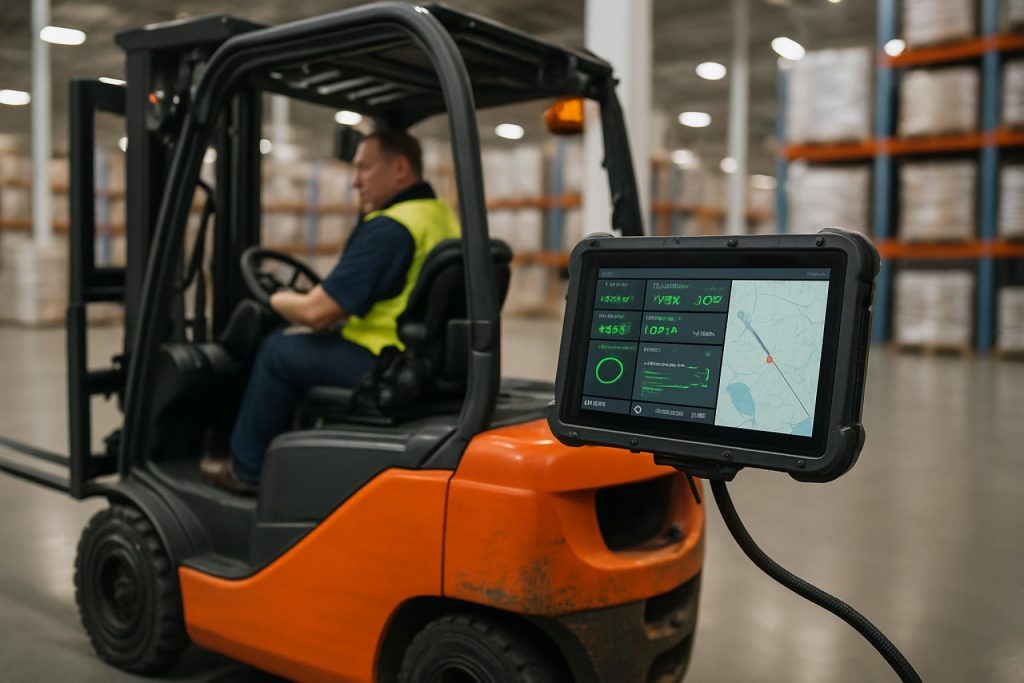
2025 Forklift Telematics Management Systems Market Report: Trends, Forecasts, and Strategic Insights for the Next 5 Years. Explore Key Technologies, Regional Dynamics, and Competitive Strategies Shaping the Industry.
- Executive Summary & Market Overview
- Key Technology Trends in Forklift Telematics Management Systems
- Competitive Landscape and Leading Players
- Market Growth Forecasts (2025–2030): CAGR, Revenue, and Volume Analysis
- Regional Analysis: North America, Europe, Asia-Pacific, and Rest of World
- Future Outlook: Innovations and Market Evolution
- Challenges, Risks, and Emerging Opportunities
- Sources & References
Executive Summary & Market Overview
Forklift Telematics Management Systems (FTMS) are integrated digital solutions designed to monitor, analyze, and optimize the performance, safety, and utilization of forklift fleets in real time. These systems leverage IoT sensors, cloud connectivity, and advanced analytics to provide actionable insights into vehicle location, operator behavior, maintenance needs, and operational efficiency. As of 2025, the global FTMS market is experiencing robust growth, driven by the increasing adoption of Industry 4.0 practices, heightened safety regulations, and the need for cost-effective fleet management in logistics, manufacturing, and warehousing sectors.
According to Fortune Business Insights, the global forklift market size was valued at USD 58.9 billion in 2023 and is projected to reach USD 84.5 billion by 2030, with telematics solutions playing a pivotal role in this expansion. The integration of telematics is becoming a standard across new forklift models, as manufacturers and fleet operators seek to enhance productivity, reduce downtime, and comply with stringent safety standards. Key functionalities of FTMS include real-time tracking, automated maintenance alerts, access control, impact detection, and detailed reporting on fleet utilization.
The market landscape is characterized by the presence of established telematics providers such as Jungheinrich, Toyota Material Handling, and Crown Equipment Corporation, alongside specialized software vendors offering modular and scalable FTMS platforms. Strategic partnerships between OEMs and telematics technology firms are accelerating innovation, with cloud-based and AI-driven analytics solutions gaining traction for their ability to deliver predictive maintenance and advanced safety features.
- North America and Europe remain the leading markets for FTMS adoption, propelled by regulatory mandates and the high penetration of automated material handling solutions.
- Asia-Pacific is emerging as a high-growth region, fueled by rapid industrialization, e-commerce expansion, and increasing investments in smart warehousing infrastructure.
- Key market drivers include the need to minimize operational costs, improve asset utilization, and ensure compliance with occupational safety standards such as OSHA and ISO 3691-1.
Looking ahead to 2025, the FTMS market is expected to witness continued innovation, with trends such as AI-powered analytics, integration with warehouse management systems, and the adoption of 5G connectivity shaping the competitive landscape. As digital transformation accelerates across supply chains, FTMS will play a critical role in enabling data-driven decision-making and operational excellence.
Key Technology Trends in Forklift Telematics Management Systems
Forklift Telematics Management Systems are rapidly evolving, driven by the need for greater operational efficiency, safety, and data-driven decision-making in material handling environments. In 2025, several key technology trends are shaping the landscape of these systems, reflecting both advancements in digital infrastructure and the growing demands of logistics and warehousing sectors.
- Integration of IoT and Edge Computing: Modern forklift telematics systems are increasingly leveraging the Internet of Things (IoT) and edge computing to enable real-time data collection and processing directly on the forklift. This reduces latency and allows for immediate insights into vehicle health, operator behavior, and environmental conditions. According to Gartner, IoT adoption in industrial settings is expected to grow by over 14% in 2024, setting the stage for even broader deployment in 2025.
- Advanced Analytics and AI: The integration of artificial intelligence (AI) and machine learning algorithms is enabling predictive maintenance, anomaly detection, and optimization of fleet utilization. These capabilities help reduce downtime and extend equipment lifespan. Mordor Intelligence highlights that AI-driven analytics are becoming a standard feature in new telematics solutions, providing actionable insights for fleet managers.
- Enhanced Connectivity and 5G Adoption: The rollout of 5G networks is facilitating faster and more reliable data transmission between forklifts and central management platforms. This is particularly beneficial for large-scale operations with multiple sites, as it ensures seamless communication and real-time monitoring. Ericsson projects that 5G connections will surpass 1.5 billion globally by 2025, accelerating the adoption of connected industrial vehicles.
- Focus on Operator Safety and Compliance: Telematics systems are incorporating advanced safety features such as real-time operator monitoring, automated access control, and incident reporting. These enhancements support compliance with evolving safety regulations and help reduce workplace accidents. European Agency for Safety and Health at Work notes that digital safety solutions are increasingly prioritized in industrial environments.
- Cloud-Based Fleet Management Platforms: The shift toward cloud-based telematics platforms is enabling centralized data storage, remote access, and integration with other enterprise systems such as warehouse management and ERP solutions. This trend is expected to continue, with IDC forecasting robust growth in cloud adoption across industrial sectors.
These technology trends are collectively transforming forklift telematics management systems into intelligent, connected, and proactive tools that drive productivity, safety, and cost savings for organizations in 2025 and beyond.
Competitive Landscape and Leading Players
The competitive landscape for forklift telematics management systems in 2025 is characterized by rapid technological innovation, strategic partnerships, and a growing emphasis on data-driven fleet optimization. The market is moderately consolidated, with a mix of established industrial automation giants and specialized telematics providers vying for market share. Key players are leveraging advancements in IoT, AI, and cloud computing to differentiate their offerings and address the evolving needs of logistics, warehousing, and manufacturing sectors.
Leading the market are companies such as Toyota Material Handling, which integrates telematics into its fleet management solutions, offering real-time monitoring, predictive maintenance, and operator performance analytics. Crown Equipment Corporation is another major player, with its InfoLink system providing actionable insights on fleet utilization, safety compliance, and energy consumption. Jungheinrich AG and Linde Material Handling have also expanded their telematics portfolios, focusing on seamless integration with warehouse management systems and advanced reporting capabilities.
Specialized telematics providers such as GemOne and PowerFleet are gaining traction by offering brand-agnostic solutions that can be retrofitted to mixed fleets, a key differentiator in multi-brand environments. These companies emphasize open APIs, customizable dashboards, and robust data security, catering to enterprises seeking flexibility and scalability.
Strategic collaborations are shaping the competitive dynamics. For instance, Hyster-Yale Materials Handling has partnered with telematics software developers to enhance its Hyster Tracker and Yale Vision platforms, enabling advanced geofencing, impact detection, and remote diagnostics. Meanwhile, Mitsubishi Logisnext is investing in cloud-based telematics to support predictive analytics and remote fleet management.
- Market leaders are prioritizing cybersecurity and compliance with data privacy regulations, responding to customer concerns about sensitive operational data.
- There is a trend toward subscription-based models, allowing customers to scale telematics features according to operational needs and budget constraints.
- Emerging players are focusing on AI-driven analytics and machine learning to provide predictive insights and automate maintenance scheduling.
Overall, the competitive landscape in 2025 is defined by a blend of innovation, integration, and customer-centric service models, with leading players continuously enhancing their telematics platforms to capture a growing share of the global forklift fleet management market.
Market Growth Forecasts (2025–2030): CAGR, Revenue, and Volume Analysis
The global forklift telematics management systems market is poised for robust growth between 2025 and 2030, driven by increasing demand for operational efficiency, safety compliance, and data-driven fleet management in logistics and warehousing sectors. According to projections by MarketsandMarkets, the market is expected to register a compound annual growth rate (CAGR) of approximately 15% during this period. This acceleration is attributed to the rapid adoption of Industry 4.0 practices, integration of IoT technologies, and the growing emphasis on real-time asset tracking.
Revenue forecasts indicate that the global market size, valued at around USD 1.2 billion in 2024, will surpass USD 2.4 billion by 2030. This doubling in market value reflects both organic growth in established regions such as North America and Western Europe, and significant expansion in Asia-Pacific, where e-commerce and manufacturing activities are intensifying. Fortune Business Insights highlights that China and India, in particular, are expected to contribute substantially to volume growth, as logistics infrastructure modernizes and regulatory frameworks mandate enhanced safety and reporting standards.
In terms of volume, the number of forklifts equipped with telematics solutions is projected to grow from approximately 1.5 million units in 2025 to over 3.2 million units by 2030. This surge is underpinned by fleet operators’ increasing preference for predictive maintenance, remote diagnostics, and driver behavior analytics, which collectively reduce downtime and operational costs. IDC reports that telematics penetration rates in new forklift sales are expected to exceed 60% globally by 2030, up from just 35% in 2025.
- CAGR (2025–2030): ~15%
- Revenue (2030): >USD 2.4 billion
- Volume (2030): >3.2 million units equipped
Key growth drivers include the proliferation of cloud-based telematics platforms, integration with warehouse management systems, and the increasing use of AI for fleet optimization. As digital transformation accelerates across supply chains, forklift telematics management systems are set to become a standard feature, further fueling market expansion through 2030.
Regional Analysis: North America, Europe, Asia-Pacific, and Rest of World
The global forklift telematics management systems market is experiencing robust growth, with regional dynamics shaped by industrialization, regulatory frameworks, and digital transformation initiatives. In 2025, North America, Europe, Asia-Pacific, and the Rest of the World (RoW) each present distinct opportunities and challenges for market participants.
- North America: The North American market, led by the United States and Canada, is characterized by early adoption of telematics and a strong focus on workplace safety and operational efficiency. Stringent Occupational Safety and Health Administration (OSHA) regulations and the presence of major logistics and e-commerce players drive demand for advanced forklift telematics solutions. The region also benefits from a mature IT infrastructure, facilitating seamless integration of telematics with warehouse management systems. According to Fortune Business Insights, North America remains a key revenue contributor, with high penetration rates among large fleet operators.
- Europe: Europe’s market is propelled by strict environmental and safety regulations, particularly in Germany, France, and the UK. The European Union’s push for sustainability and carbon footprint reduction encourages the adoption of telematics for optimizing fleet utilization and energy consumption. Additionally, the region’s strong manufacturing and automotive sectors are investing in digital transformation, further boosting telematics uptake. MarketsandMarkets highlights that Europe is witnessing increased demand for electric forklifts equipped with telematics, reflecting the region’s green logistics agenda.
- Asia-Pacific: Asia-Pacific is the fastest-growing region, driven by rapid industrialization, expanding e-commerce, and significant investments in smart warehousing, especially in China, Japan, and India. The region’s large-scale manufacturing and logistics operations are increasingly adopting telematics to enhance productivity and reduce operational costs. However, market fragmentation and varying levels of digital maturity present challenges. Mordor Intelligence notes that local and multinational telematics providers are expanding their presence to tap into the region’s vast potential.
- Rest of the World (RoW): In regions such as Latin America, the Middle East, and Africa, adoption of forklift telematics is at a nascent stage but is expected to grow as supply chain modernization accelerates. Infrastructure development projects and the gradual shift towards automation are key drivers, though budget constraints and limited awareness may slow uptake in the short term. Nonetheless, Allied Market Research projects steady growth as global OEMs and technology vendors increase their outreach in these emerging markets.
Future Outlook: Innovations and Market Evolution
The future outlook for forklift telematics management systems in 2025 is shaped by rapid technological innovation, evolving regulatory requirements, and the growing demand for operational efficiency in material handling. As supply chains become increasingly digitized, telematics solutions are expected to play a pivotal role in transforming forklift fleet management, safety, and productivity.
One of the most significant innovations anticipated is the integration of artificial intelligence (AI) and machine learning algorithms into telematics platforms. These technologies will enable predictive maintenance, real-time anomaly detection, and advanced analytics, allowing operators to minimize downtime and optimize fleet utilization. For example, AI-driven insights can forecast component failures before they occur, reducing unplanned maintenance costs and improving asset longevity.
Another key trend is the expansion of Internet of Things (IoT) connectivity. Forklift telematics systems are expected to leverage 5G networks for faster, more reliable data transmission, supporting real-time location tracking, geofencing, and remote diagnostics. Enhanced connectivity will also facilitate seamless integration with warehouse management systems (WMS) and enterprise resource planning (ERP) platforms, enabling end-to-end visibility across logistics operations.
Safety and compliance will remain central to market evolution. In 2025, telematics solutions are projected to incorporate more sophisticated driver behavior monitoring, including fatigue detection, collision avoidance, and automated incident reporting. These features will help companies adhere to stricter occupational safety regulations and reduce workplace accidents, a priority highlighted by organizations such as the Occupational Safety and Health Administration.
Market analysts forecast robust growth for the forklift telematics sector. According to Fortune Business Insights, the global forklift telematics market is expected to expand at a compound annual growth rate (CAGR) exceeding 12% through 2025, driven by increased adoption in manufacturing, retail, and logistics industries. Leading providers such as Jungheinrich, Toyota Industries Corporation, and Hyster-Yale Materials Handling are investing heavily in R&D to deliver next-generation telematics solutions tailored to diverse operational needs.
In summary, 2025 will see forklift telematics management systems evolve into intelligent, interconnected platforms that not only enhance fleet efficiency but also drive safety, compliance, and sustainability across the material handling landscape.
Challenges, Risks, and Emerging Opportunities
The forklift telematics management systems market in 2025 faces a complex landscape of challenges, risks, and emerging opportunities as digital transformation accelerates across logistics and warehousing. One of the primary challenges is the integration of telematics solutions with legacy fleet management systems. Many warehouses and distribution centers operate with a mix of old and new equipment, making seamless data integration and interoperability a persistent hurdle. This can lead to fragmented data silos, reducing the effectiveness of telematics insights and complicating fleet optimization efforts.
Cybersecurity risks are also intensifying as telematics systems become more connected. The increased flow of sensitive operational data between forklifts, cloud platforms, and enterprise resource planning (ERP) systems exposes organizations to potential data breaches and cyberattacks. According to IBM, the average cost of a data breach continues to rise, underscoring the need for robust security protocols in telematics deployments.
Another significant risk is the potential for regulatory non-compliance. As governments introduce stricter safety and emissions standards, telematics systems must be updated to ensure compliance reporting and real-time monitoring. Failure to adapt to evolving regulations can result in fines and operational disruptions, particularly in regions with aggressive environmental targets such as the EU and North America (U.S. Environmental Protection Agency).
Despite these challenges, several emerging opportunities are shaping the market outlook for 2025. The adoption of artificial intelligence (AI) and machine learning within telematics platforms is enabling predictive maintenance, real-time safety alerts, and advanced analytics for fleet optimization. This not only reduces downtime but also enhances operator safety and asset utilization. According to Gartner, the AI software market is projected to reach $297 billion by 2025, with logistics and fleet management as key growth sectors.
Additionally, the rise of 5G connectivity is expected to unlock new capabilities for forklift telematics, such as real-time video monitoring and ultra-low latency communications. This will facilitate more sophisticated safety features and remote diagnostics, further driving adoption. As sustainability becomes a core focus, telematics systems that support energy-efficient operations and emissions tracking are likely to see increased demand, especially among companies pursuing ESG goals (McKinsey & Company).
Sources & References
- Fortune Business Insights
- Toyota Material Handling
- Crown Equipment Corporation
- Mordor Intelligence
- European Agency for Safety and Health at Work
- IDC
- Linde Material Handling
- GemOne
- PowerFleet
- Hyster-Yale Materials Handling
- MarketsandMarkets
- Allied Market Research
- Toyota Industries Corporation
- IBM
- McKinsey & Company
https://youtube.com/watch?v=E4bVynnd_mo



